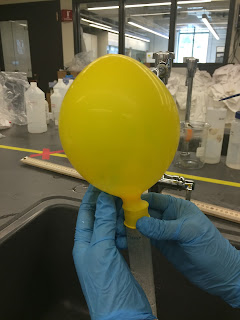Lab 18: Alka Seltzer and the Ideal Gas Law
I. Introduction: In this lab the purpose was to measure the reaction between Alka Seltzer and water and to determine the mass of the gas produced. What we did was, first we smashed up an alka seltzer tablet and put it inside a balloon. We then put the balloon over a graduated cylinder full of water and as the two substances combined, CO2 was produced and collected in the balloon. After all the gas had been created we measured the circumference of the balloon. We then emptied the gas and refilled the balloon with water until it had the same circumference. From this we were able to measure the water and find the volume. Through a series of calculations , we were able to conclude that the mass of CO2 was around 1.26 grams in our experiment.
II. Data:


There are many instances where an experimental error may have occurred For example, we could have inaccurately measured the circumference of the CO2-filled balloon as it was hard to measure accurately with a piece of string . Also we know that some water escaped the balloon as we were trying take it off the sink head and pour it into the graduated cylinder which could have threw our data off.
1.38 grams of CO2.
II. Data:
III. Calculations:


(Setup)
IV: Analysis Questions:
1. Discuss an area in this lab where experimental error may have occurred.
There are many instances where an experimental error may have occurred For example, we could have inaccurately measured the circumference of the CO2-filled balloon as it was hard to measure accurately with a piece of string . Also we know that some water escaped the balloon as we were trying take it off the sink head and pour it into the graduated cylinder which could have threw our data off.
2.Choose one error from above and discuss if it would make "n" the number of moles of CO2 too big or too small.
Due to the fact that we lost water, while in the process of removing the balloon from the sink, it would have made our moles of CO2 smaller because we would have less volume than the actual balloon. We can tell by Avogadro's Law, since volume has a direct relationship with mass according to Avogadro's law, the number of moles ("n") of CO2 would be too small.
3. Filling the balloon with water may be one place where error could have occurred. Using the value for the circumference of the balloon in cm, calculate the volume of the balloon mathematically.
31.00cm= 2πr --> r= 4.94cm; V=4/3π (4.94cm)^3= = 505mL
4. Compare your answer to #3 to the volume obtained by filling the balloon with water. Is it close? Which do you feel is more accurate and why?
Our to volumes were not close at all because of the human error that we had made.I feel the mathematical is more accurate because it gives an answer without human error and instead straight from stats and data.
5. The ideal gas law technically applies to ideal gases. Give two differences between a real gas and an ideal gas.
Ideal gases are said to have "point mass" meaning that the mass is so small that it is considered to be zero. However, real gases have mass and volume even though they may be very small. Another difference is that ideal gas collisions are elastic meaning that the particles are not attracted or repulsed by each other so they kinetic energy will remain constant. For real gases, collisions of particles are non-elastic so the particles may have strong attractive or repulsive forces between them.
6. Would the CO2 you collected in this lab be considered ideal?
The CO2 in this lab would not be considered an ideal gas because ideal gases don't exist and our CO2 gas takes up mass and volume.
V. Advanced Questions:
1. Using the information provided on the label, and stochiometry, calculate the mass of CO2 that should be collected.
1.38 grams of CO2.
2. What percent is the percent yield for the CO2 collected in your sample?
Percent Yield: (Experimental/ Theoretical)
PY: 1.26/1.38/2= 45.5 percent
3. CO2 is water soluble. The solubility around room temperature is around 90mL/100mL of water. What effect does this have on your calculated "n" value?
This means that some of the carbon dioxide might have dissolved into the water. If this is the case, that would explain why my experimental yield was smaller than the theoretical yield. The fact that CO2 is soluble made my calculate molar mass go down from what it should have actually been.



Comments
Post a Comment